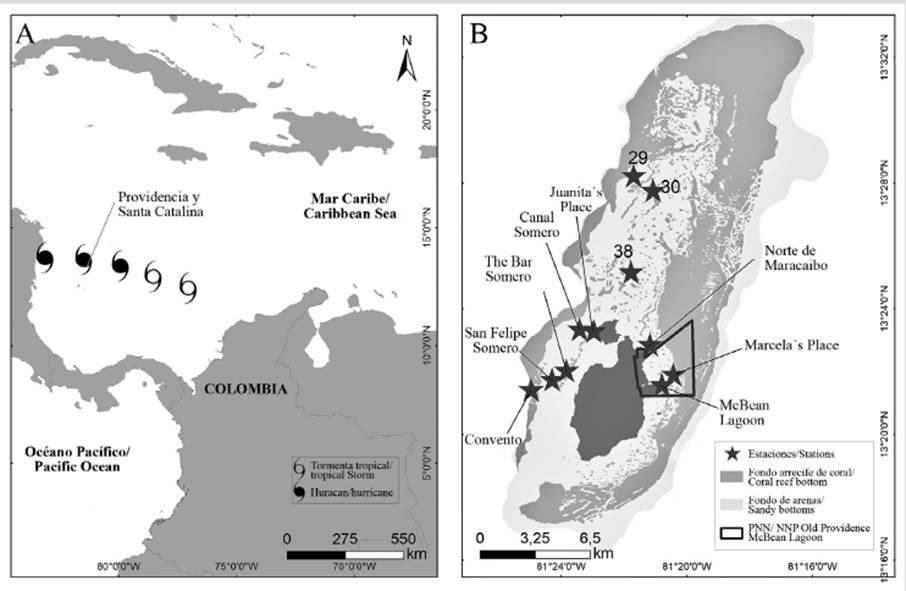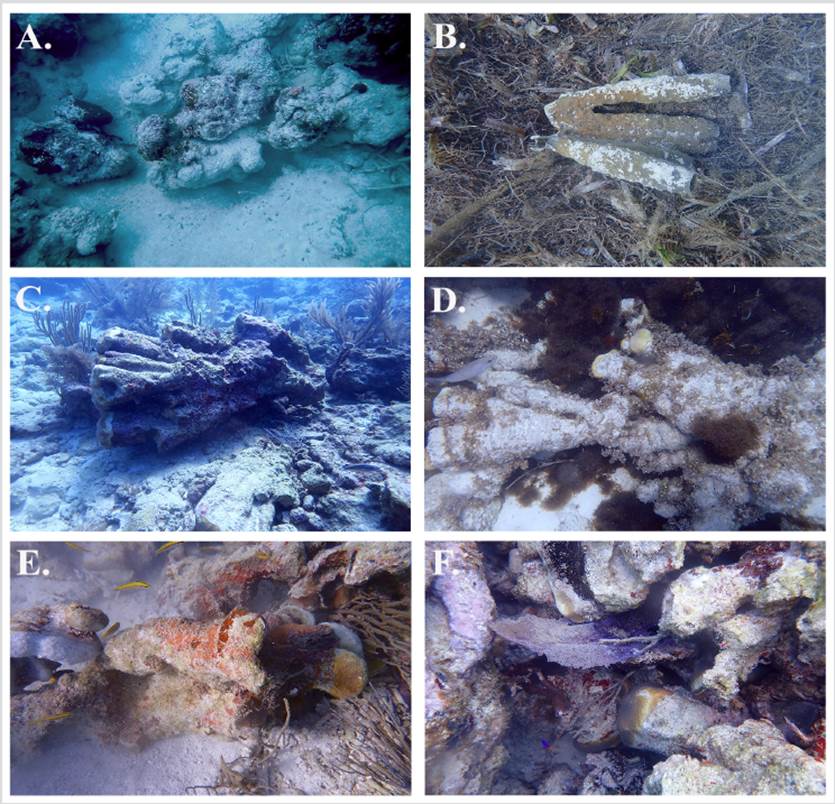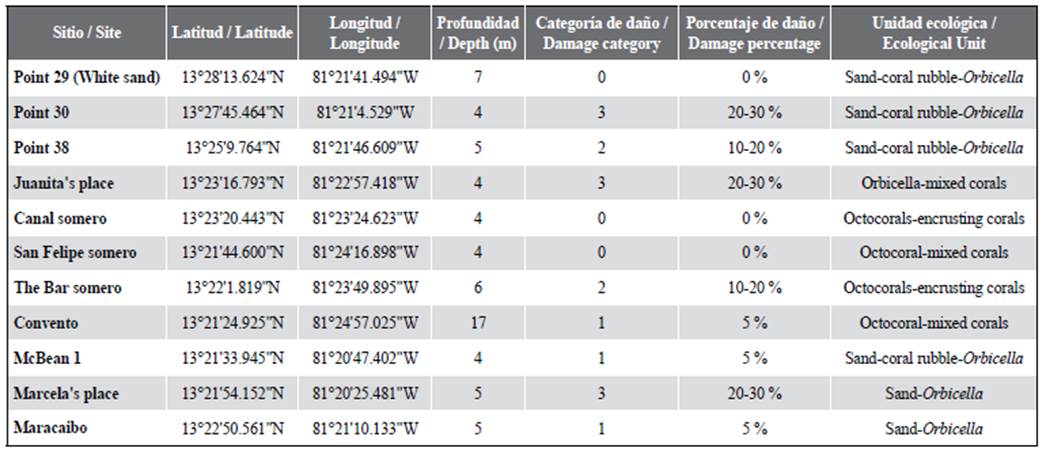Tropical cyclones are one of the most important natural destructive forces for coral reefs (Harmelin-Vivien, 1994). Most form as low-pressure centers that make contact with the ocean and normally occur when seawater temperatures are above 26 °C (Done, 1992). Modelling studies have suggested that increasing ocean temperature due to climate change show a positive correlation with the intensity of hurricanes that reached category 4-5 on the Saffir-Simpson scale (Saunders and Harris, 1997; Webster et al., 2005; Mann and Emanuel, 2006; Knutson et al., 2010), at least for the past five decades (Emanuel, 2005). Common damages to coral reefs include fragmentation and overturning of colonies, sediment cover, increased turbidity and, in general, changes in the structural component of the habitat, which can range from a very localized to entire reefs (Woodley et al., 1981; Rogers et al., 1991; Gardner et al., 2005; Beeden et al., 2015).
In the last 60 years, roughly a dozen major hurricanes (category > 3) have crossed the Caribbean region from east to west causing considerable damage to reef ecosystems (Woodley et al., 1981;Knowlton et al., 1990; Bythell et al., 1993; Edmunds, 2019). Within the same period of time, at least six hurricanes category 1 or more have had an impact on the oceanic islands of Colombia (Ortiz, 2007). The last major physical disturbance that affected Providencia was hurricane Beta in 2005 (category 1, lowest pressure 962 mb), which crossed 15 km north causing damages in the north sections of the barrier reef complex as well as the patch-reefs around the island (Taylor et al., 2007, Rodríguez-Ramírez and Reyes-Nivia, 2008). It has been suggested that part of the historical decline in coral cover in San Andrés and Providencia islands has been exacerbated by different storms and hurricanes that caused damage to the reef framework, such as, the almost disappearance of Acropora cervicornis after hurricane Hattie in 1961, and the damage to A. palmata and massive coral heads of Diploria and Pseudodiploria presumably by hurricane Joan in 1988 (Zea et al., 1998).
On November 16th 2020, between 4:00-7:00 the eye of the hurricane Iota passed at a distance of less than 10 km north of Providencia and Santa Catalina islands with sustained winds of Saffir-Simpson category 5 (> 250 km h-1), minimum surface pressure of approximately 917 mb, and storm surge of 6 m (DIMAR, 2020). This is the first category 5 hurricane that has had a direct impact on the island and the second largest in recent history that has occurred in the month of November (https://www.nhc.noaa.gov/archive/2020/al31/al312020.public_a.011.shtml) (Figure 1). With unprecedented consequences, the hurricane caused a destruction of almost 95 % the infrastructure of Providencia and Santa Catalina’s inland area, affecting the forest foliar mass, mangroves, seagrass meadows, and coral reefs. The purpose of this study is to document the overall magnitude of the impact of Iota on coral reef formations around the islands.

Figure 1 A) Map of the southwestern Caribbean Sea showing the Island of Providencia and Santa Catalina with the approximate hurricane track from tropical storm to hurricane category 5 (National Hurricane Center-NOAA), and B) surveyed stations.
As part of the “Operación Cangrejo Negro” established by the Colombian government trough the “Sistema Nacional Ambiental-SINA” and three weeks after Iota impacted the islands, visual assessments (SCUBA) were performed to evaluate 11 representative coral reef formations in the shallow northern part of the barrier reef, the coral-reef terraces form the leeward side and the lagoonal patch-coral formations inside the Old Providence McBean Lagoon National Natural Park, between 2 and 17 m depth (Figure 1, Table 1). Estimates of the severity of the damage within each station (~200 m2) were categorized by each team member independently (five divers) who gave an estimated proportion of coral cover impacted (0 to 100 %), which was then categorized with score values ranging from 0 to 5 according to Beeden et al. (2015), with values from 1 to 3 referred as minor to moderate colony-level damage / minor structural damage, while values of 4 and 5 referred as severe to extreme coral damage / high reef structural damage (Table 1). Although these estimates are approximate values, a consensus from the different observers was reach once on-board in order to minimize bias. These surveys complemented the qualitative assessment performed by Sánchez et al. (2020), who first evaluated deeper sites around the island.
We found a generalized impact in 72 % of the stations on both sides of the island. The damage was concentrated on shallow areas (5-7 m) and was generally within coral reef formations. Approximately 45 % of the sites had low to low-medium damage (10-20 %, category < 2) and 27 % showed medium to moderate damage (20-30 %, category 3). Particularly, Point 30, Juanita’s Place and Marcela’s Place (Table 1, Figure 1), had higher structural damage (up to 30 %) compared to the other locations. At these sites, there were areas with partially collapsed reef structure, and coral rubble was observed as well as partial removal of gorgonian octocorals (Figure 2).

Figure 2 Impacts seen around the island. A. partially collapsed colony cover by sand, B. detached sponge seen on sand channels on top of debris, C. - F. Orbicella annularis fragmented and overturned along with attached octocorals found at the stations that had the highest score damage.
Point 30 is a typical patch reef located in the lagoon and the substrate is dominated by sand-coral rubble along with coral formations such as Orbicella annularis-faveolata and octocorals. The presence of gravel and recently exposed rock was noticeable, likewise overturned and fragmented colonies, especially O. annularis; octocorals were observed covered by sand. The patch reef Juanita’s place located on the edge of Santa Catalina Island in an area locally known as Channel Shoal (Figure 1), was the site with the highest living coral cover (~ 34 %). Large massive colonies of O. annularis, O. faveolata (some over 2 m high) and Pseudodiploria strigosa structured the bottom, along with Porites astreoides and the foliaceous coral Agaricia agaricites. We found that colonies mainly O. annularis and P. strigosa were fragmented and overturned. At this station we observed stripes-shaped damage, caused presumably by rolling corals and big boulders that were transported across the reef by the bottom currents (e.g., Woodley et al., 1981; Edmunds and Witman 1991). Marcela’s Place, is a patch reef located at the eastern side of the island in the lagoon, with good development of large massive colonies of O. annularis and O. faveolata, as well as P. strigosa and Siderastrea siderea. In this place we observed considerable impact, especially in O. annularis and O. faveolata. Most of the colonies that were found on the edge of the patch reef close to the sand-planes were impacted, overturned and some ended up covered by sand and debris. Particularly, we observed the greatest damage for O. annularis on colonies with columnar-lobated growth, already under the effects of bioerosion. Similarly, massive colonies of P. strigosa with a thin peduncle were also affected.
We observed widespread coral bleaching in all the surveyed stations, which was more likely associated with the increased temperature previous to the hurricane, (~ 30 °C) as had been found by Rodríguez-Ramírez and Reyes-Nivia (2008) after hurricane Betta in 2005. This phenomenon has been reported in other parts of the Caribbean as well, where hurricane activity often correlates with widespread bleaching events (Manzello et al., 2007). Likewise, we observed few colonies of P. strigosa, S. siderea, Favia fragum, Monstastraea cavernosa, A. agaricites and A. cervicornis affected by the black band, white band and dark spot diseases (Gil-Agudelo et al., 2009; Navas-Camacho et al., 2010). Important questions arise about 1) what is the fate of coral recovery following the hurricane impact? and 2) Is it the period equivalent to the natural periodicity of hurricanes for this region long enough for the coral community to return to pre-hurricane conditions? From this preliminary assessment we can conclude that the impact was widespread along the island mainly on shallow areas structured by big boulders of Orbicella spp.; however, it was focalized within reef areas mainly related to colony-level damage with minor reef structural damage.











 text in
text in 




